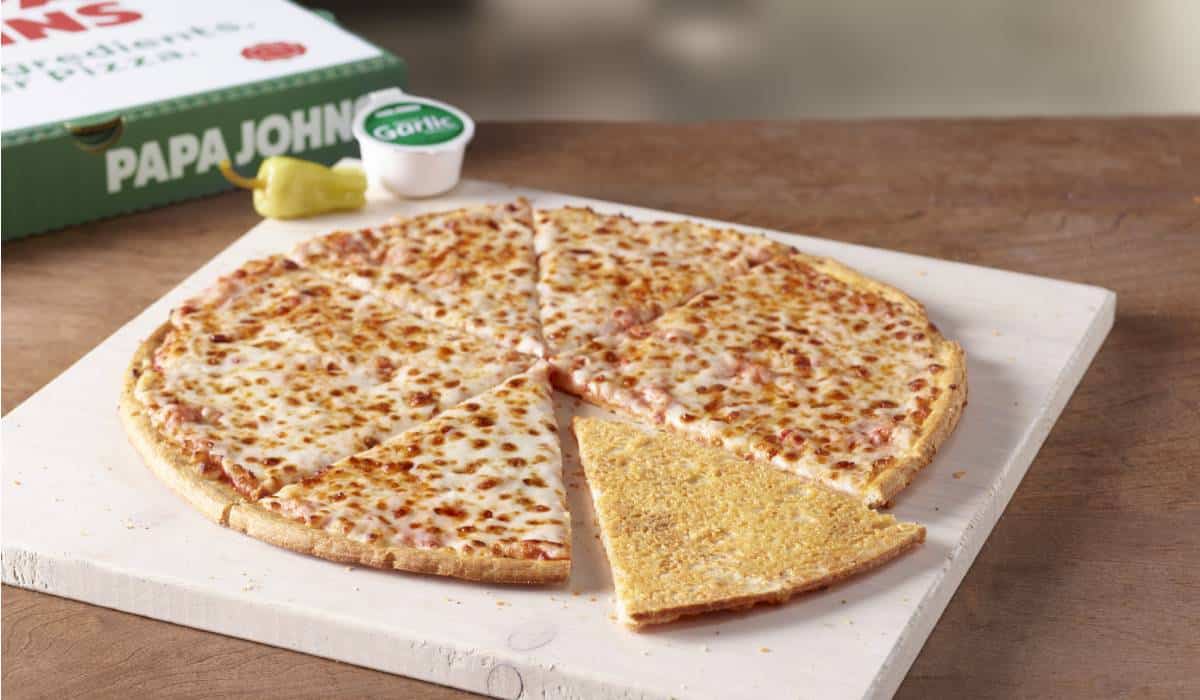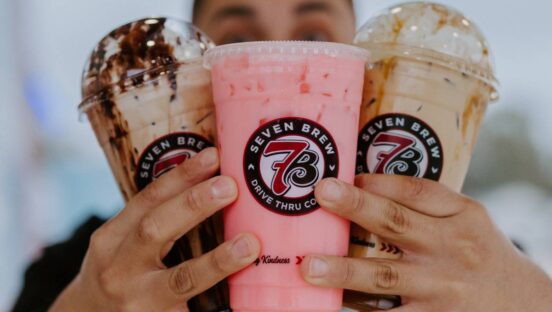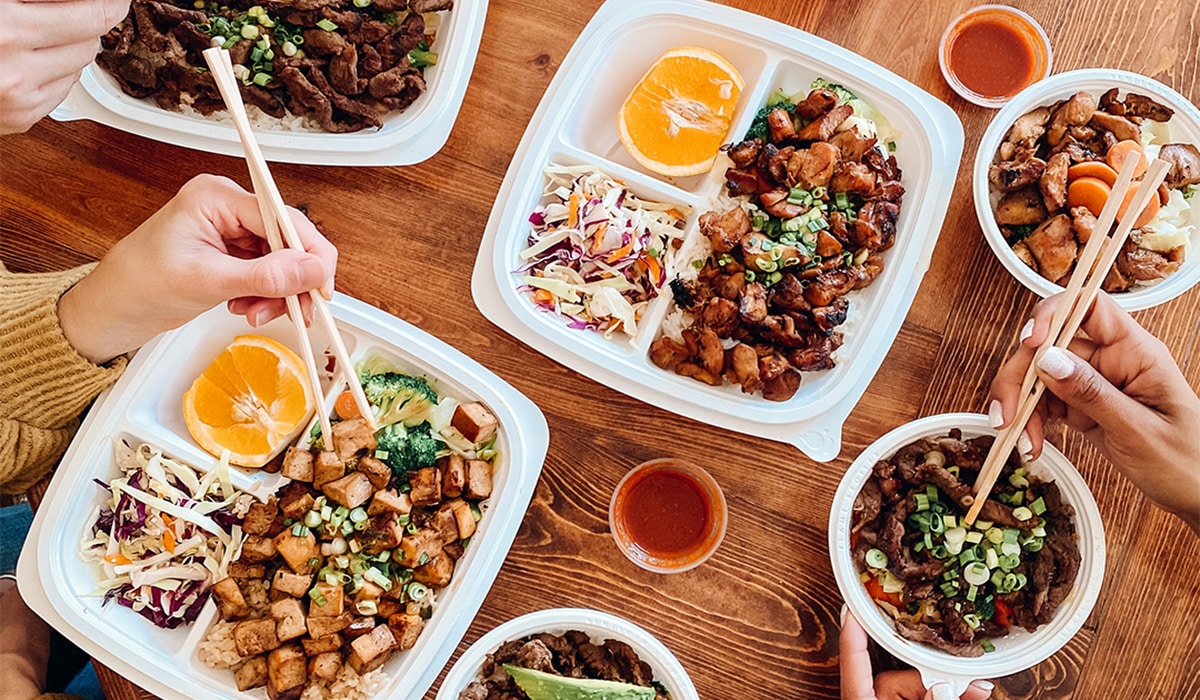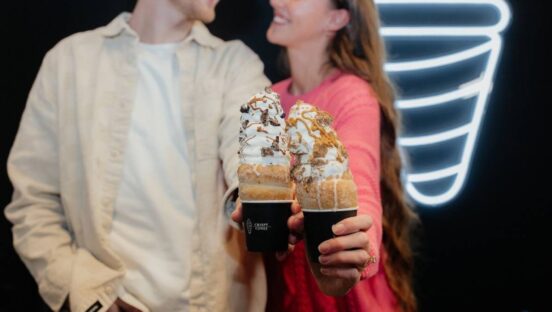Papa Johns CEO Rob Lynch poses a question: “Have you ever heard of a patent in the pizza industry before?” The brand is in the process of grabbing one for its Crispy Parm Pizza, which bakes cheese underneath the crust. Launched February, Lynch says guest response has been “fantastic.”
But beyond recent feedback, this speaks to a broader story at Papa Johns. The company produced North America same-store sales of 1 percent, year-over-year, in fiscal 2022—up 30 percent on a three-year stack. Papa Johns is the only “Big 3” public pizza brand to report positive domestic comps this past year; Pizza Hut was at negative 1 percent and Domino’s negative 0.8 percent, the latter of which marked the first red yearly result since 2008.
Additionally, Papa Johns guided 2–4 percent growth (likely toward the lower figure in 2023) on an annualized basis following three straight calendars of record sales. This will include lapping the company’s largest January on record when it launched New York Style Pizza and appreciated a tailwind from guests boarding up due to Omicron.
Papa Johns took between 7–9 percent pricing last year, depending on how you view it. Typically, the brand bumps 1–2 percent. So you could argue Papa Johns had to layer in three or four years worth of price in just 12 months. “To be able to deliver positive sales comps having to take that much pricing across our system, I think, is indicative of our ability to continue to bring innovation and continue to do things that keep our customers engaged,” Lynch says in an interview with QSR. “We’re the only ones who were able to comp positive last year in the [pizza] industry and I think we’re a little bit more bullish on 2023 than maybe some of our peers as well.”
Looking pre-COVID-19, Papa Johns was in a rather different spot. Sales dropped 12 percent in fiscal 2018, which marked the first annual decline in nine years. In North America, 128 locations shuttered in 2018 versus 79 opens. A year earlier, 186 franchises closed, along with seven corporate stores. At one point, same-store sales reported negative for seven consecutive quarters (Q4 2017 to Q2 2019).
Lynch, a former Arby’s president with a track record in turnarounds, arrived in August 2019 and got to work refining Papa Johns’ compass. This centered on leaning into Papa Johns’ premium DNA and what helped it carve a spot in a crowded category to begin with—a product-first outlier.
Papa Johns built that foundation during the pandemic, which proved a breeding ground for innovation instead of a barrier. The chain laid a strategic blueprint. Versus scrapping it come March 2020, every piece accelerated. Papa Johns launched garlic parmesan crust roughly 90 days after Lynch joined the company. It was the first time Papa Johns added to its six-ingredient, never-frozen original pizza dough. By the time 2020 ended, Papa Johns had launched six new products in a calendar year. The tone was set.
Yet three-and-half or so years later, Papa Johns sees a broader picture emerging. Today, there are more than 28 million loyalty member accounts on file, more than double the number of registered users three years ago. Across the pandemic, Papa Johns brought in “a lot” of new customers, Lynch says, but the company didn’t really move the needle on frequency. And it also focused so deeply on staffing and pandemic fixes that some operational focuses got washed over.
In Q4, Papa Johns introduced a “back to better operations” initiative focused on execution and customer experience. “While we cannot control inflation or a customer’s budget,” Lynch told investors Thursday, “we can control how effectively we execute superior operations.”
Put simply, there’s a lot of upside left in that foundation Papa Johns developed during COVID. The product innovation and digital growth (more than 85 percent of transactions are now flowing through digital channels domestically) pushed incremental guests to the top of the funnel. Lynch believes the brand can now keep customers there, and get them returning, if operations follow suit.
Papa Johns’ out-the-door time for orders taken in corporate restaurants is currently 20 minutes. That’s nearly 10 minutes faster than a year ago. Chief restaurant officer Joe Sieve joined the company in early May to spearhead the directive. He spent six years at Inspire Brands as VP of franchise development and previously built a portfolio of 58 Domino’s as a franchisee.
Lynch says there isn’t any “rocket science” involved. As the brand did everything it could to keep units open and staffed during COVID, it lost discipline on the KPIs you track and monitor to make sure you’re running great operations, he says.
New leadership restored that focus. Papa Johns changed some of the GM comp model to include operations metrics, not just financial ones. “Blocking and tackling to make sure that we’re tracking the right things,” Lynch says. “And following up on those things.”
The brand also improved its make-line efficiency and worked to ensure it had a streamlined operating model when it came to driver dispatch, using both company employees and drivers of service partners. “I think for a while there was some kind of get to some of our operators and some of our restaurants weren’t as efficient as they needed to be, and how they utilize their driver labor pool, and we’ve cleaned up a lot of that,” he says. “… It’s not like we wrote some new piece of software that’s changing everything. It really is about leadership. It really is about measuring results. And I think it’s just getting back to being great operators, which is effectively what made this company great in the first place.”
The frequency goal is hardly one to gloss over. As Lynch explains, with 28 million loyalty members, if Papa Johns can earn one more transaction per year, with an average $20 ticket, you’d be looking at nearly $500 million in incremental sales on a $3 billion baseline. “So that’s a huge opportunity for us that we’ve got to crack,” he says.
Overall, Lynch believes 2023 will resemble more of a normal operating climate than recent history. There will be inflationary concerns and who knows what else—few could have predicted geopolitical turmoil last year—but the broad landscape is one Papa Johns is eager to compete for share in.
One reason, Lynch adds, returns to those building blocks. Papa Johns hasn’t talked a lot in recent quarters about sales being negatively hit by delivery driver staffing—that’s been the case at competitors, to put it lightly. But Papa Johns mitigated the issue with partnerships on the delivery-as-a-service side, which it’s been doing for going on four years now. Those out-the-door improvements? “You don’t do that if you have a delivery staffing problem. We feel confident that we have what we need to continue to drive operational improvements,” Lynch says, adding staffing has mostly stabilized.
Papa Johns claims to be the first in its category to offer online ordering (2001) and the first to launch a nationwide digital rewards program. It’s carried that challenger mindset to third-party delivery and “PapaCall” centers, which it unveiled in August 2021. PapaCall includes an AI engine designed to feed call center agents information when customers place an order by phone. Papa Johns worked with Cognizant to implement AI and machine learning so employees could answer phones less and aid customers more. It also offers a more personalized experience with a cloud-based telephone system that recognizes repeat customers’ phone numbers and greets them by name. It stores preferences, too.
PapaCall helped the brand reduce the number of dropped calls and lost orders during peak times “dramatically.”
The loyalty program represents about 50 percent of sales. It’s providing the brand, Lynch says, with data that shapes the business to “better serve all of our customers.” Papa Johns continues to build the network through early access to new menu items and exclusive perks and discounts.
Speaking further to the aggregator point, Lynch says the third-party marketplace enabled it to reach new, incremental customers and service existing ones during high-volume periods. When staffing shortages were exacerbated by Omicron in 2022, Papa Johns leaned in. “Papa Johns leads the pizza industry when it comes to building these third-party relationships,” Lynch says. “And we will continue to further leverage this channel to introduce our brand and products to even more customers in the future.”
Again, it’s a circular approach that starts with innovation. In 2022, Papa Johns drove demand through new news on existing platforms, like Epic Pepperoni-Stuffed Crust, and Pepperoni Crusted Papadias. Then it introduced fresh options like New York Style Pizza and Papa Bowls, which were built around a premium ingredient view.
At the end of December, Papa Johns launched “Papa Bites” inspired by its Jalapeno Popper Rolls from 2020. The company elevated the snack-sized product to include Chicken Parmesan and Oreo Cookie. Lynch hinted he “just tasted some new flavors last week.”
“Our promotional calendar is flexible, but our commitment to better is not,” he says. “As I’ve discussed in previous [earnings] calls, we view value differently than discounting. Our value proposition comes from offering a variety of great products at accessible price points for all of our customers, whether that’s from our extra large, extra cheesy extra pepperoni Shaq-a-Roni or our Papa Pairings, which offers multiple items on our menu for just $6.99 each.”
“Our barbell strategy balances our menu to offer our premium products along with value options to ensure all of our customers are getting the products they want at great prices,” he adds.
READ MORE: Papa Johns Finds the Value Sweet Spot
Lynch says Papa Johns has a “whole pipeline of stuff” coming across the balance of 2023. But it’s all going to fall in line with what’s already unfolded—“our goal is to meet our customers where they are, no matter what,” Lynch says.
That’s why Papa Johns chose a different aggregator path than most pizza players, far earlier. “It’s not about what we want to do, it’s about what they want,” Lynch says of guests. “And that drives us to do what we do.”
Papa Pairings, for instance, arrived in late Q3, early Q4, and offers a value-seeker entry point. But it is far from a straight discount. It’s a platform that presents different products, including pizza, and allows the brand to promote varied options, like wings, but also to encourage customers to ladder up and build check as they see fit. “We look at that quote on quote, value platform as not just a discount but as a way to drive people into products they may not typically try or even have awareness that we have at Papa Johns,” Lynch says. “There’s some strategic value there. We’re going to keep innovating up against that $6.99 platform. We think that there’s a customer out there and that customer base is growing to a certain extent as the economic challenges that we are all facing continue. But we’re going to keep innovating on that premium side, too.”
The growth runway
This past year, Papa Johns expanded its systemwide footprint by 4.5 percent with the opening of 378 new restaurants. This included six restaurants in new market Honduras in Q4. At the end of 2022, Papa Johns was in 48 countries and territories, “leaving us with significant whitespace for further expansion moving forward,” Lynch says.
For perspective on this runway, Papa Johns has about half as many restaurants as its two largest competitors domestically, and about a third internationally. They compete in nearly 100 countries while Papa Johns is in only 48.
International same-store sales were down 3 percent in 2022 from a year ago and up 20 percent on a three-year stack. That was mostly a U.K. challenge—Papa Johns largest international market (about 20 percent of overseas sales) and the only it owns the commissary. The brand is preparing to spend $2–$3 million in targeted marketing to aid U.K. operators. If you remove the U.K., Lynch says, Papa Johns’ international business comped positive last year. China, the Middle East, and Central America, ramped up growth in particular. Lynch says the U.K. challenges are “not necessarily Papa Johns specific” but more tied to external challenges.
At year’s end, Papa Johns had 3,376 North America units (2,854 franchised) and 2,330 international. The 2022 development broke down as 86 North America openings (76 franchises) against 49 closures and 292 international openings versus 85 closures. Papa Johns also refranchised 90 domestic corporate stores.
This coming year’s outlook is between 270–310, which would represent the largest development year in Papa John’s history. “People are excited internationally, globally. It’s not just one region,” Lynch says. “We’ve got multiple regions, Asia, Middle East, South America, that are all going to be rowing pretty significantly from a unit count standpoint this year.”








